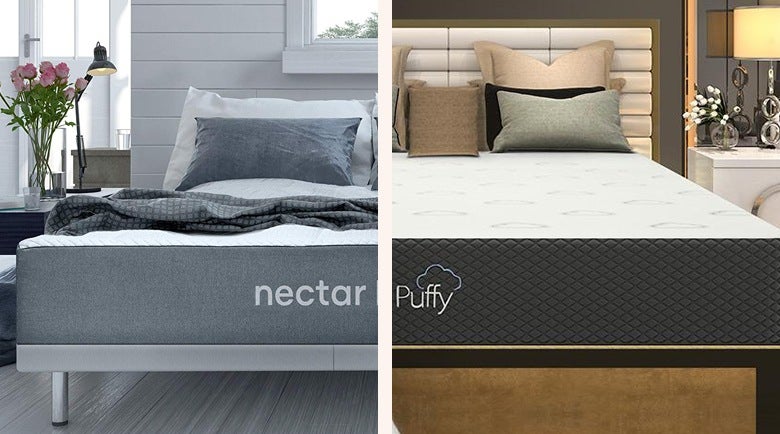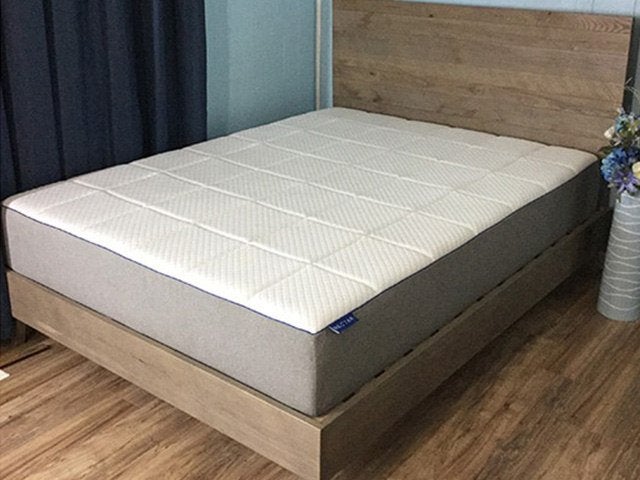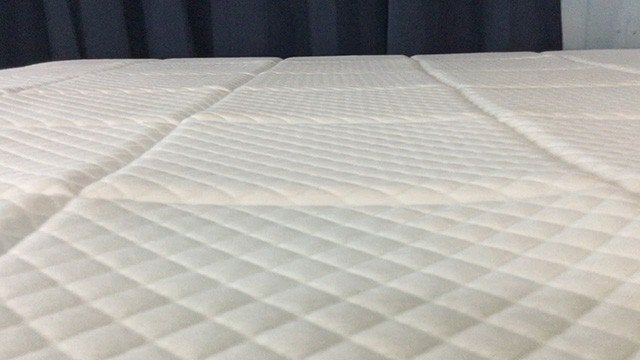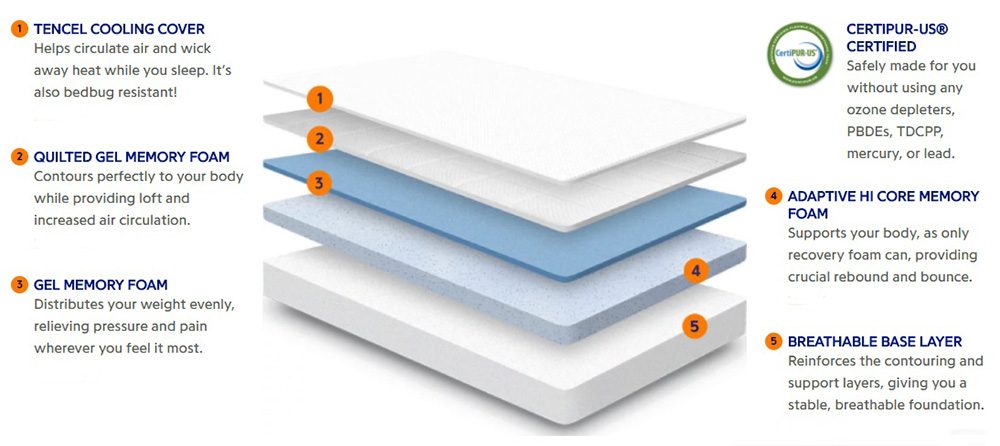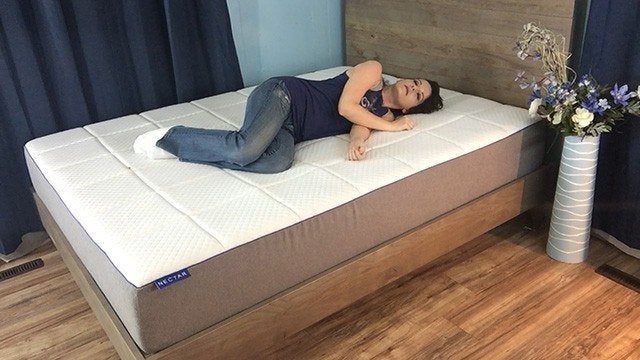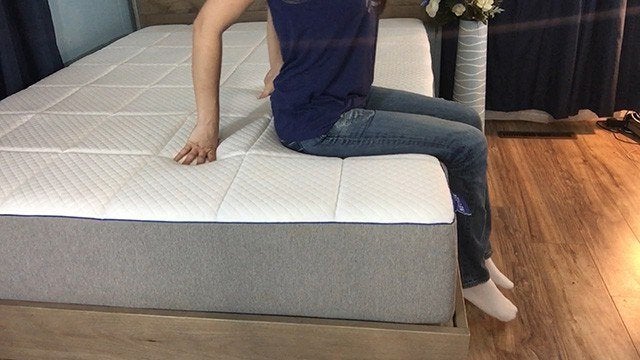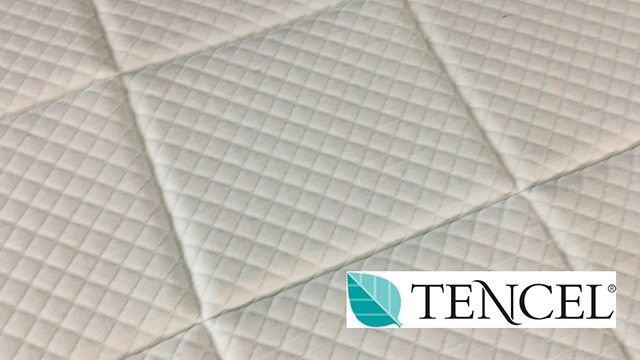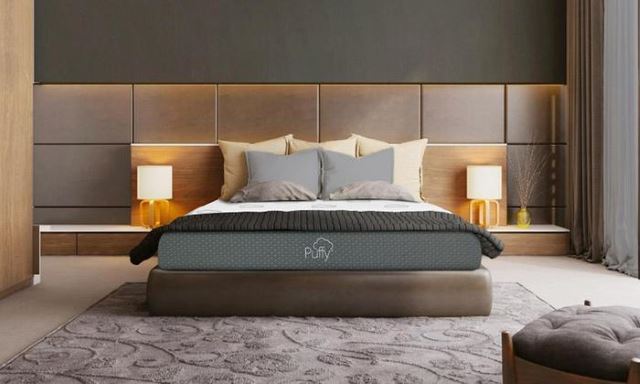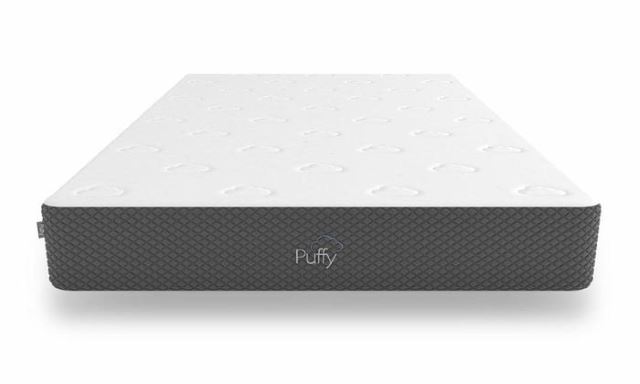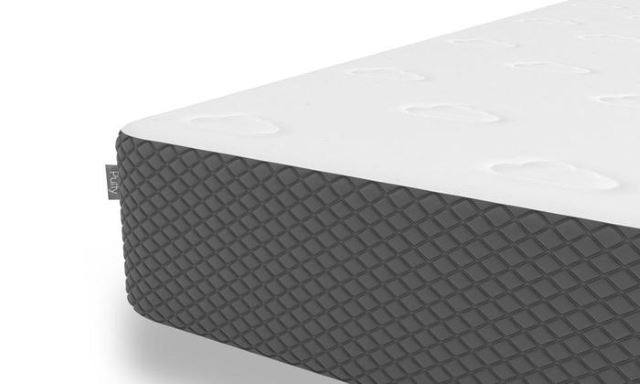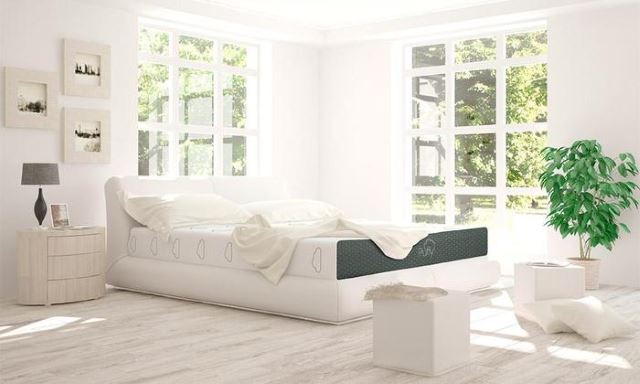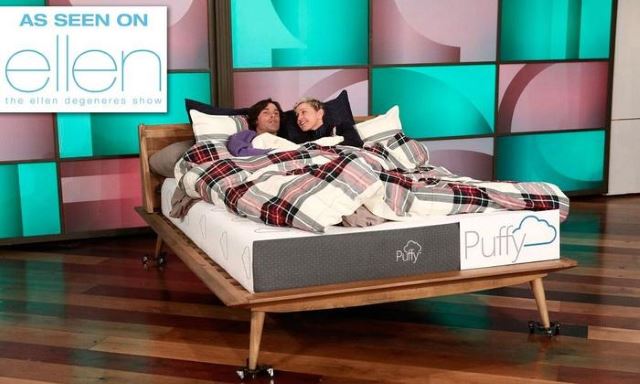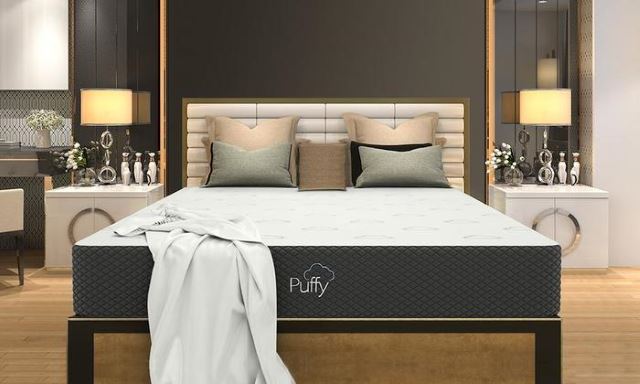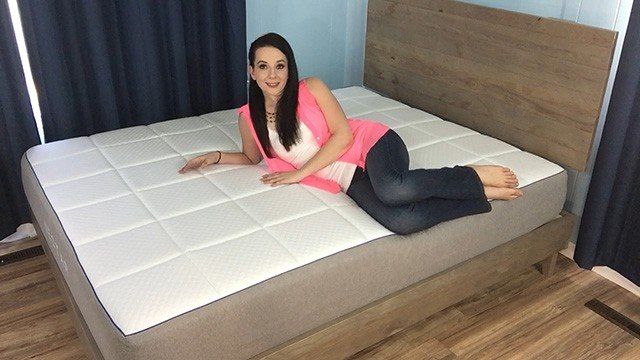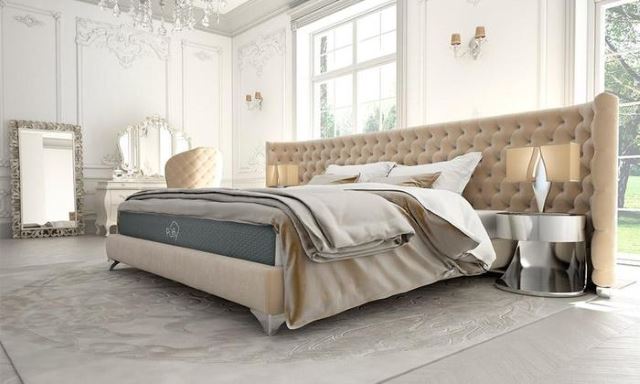Memory foam (or viscoelastic foam) has revolutionized the sleep industry since NASA made it publicly accessible in the 1980s. Over the past few decades, various manufacturers have added their own innovations to the material to enhance (or mitigate) some of its inherent properties.
This Puffy vs Nectar comparison contrasts the attempts of two different mattress makers to deal with slow sinkage problem that is common in ordinary memory foam because of its highly contouring nature. Both mattresses are sold online and are affordably priced, while claiming to offer a highly relaxing and supportive sleep experience.
Read on to find out how they fare against each other.
Nectar Breakdown
The Nectar is a classic memory foam mattress with a twist: it uses a heavy, tough variety of memory foam as an intermediate layer to reduce sinkage and enhance its lumbar support.
Construction
Cover
A cover made from Tencel® fabric encompasses the four layers that make up the Nectar. Tencel is an organic-based fabric that is created from eucalyptus. It is soft and breathable in nature (in fact, it has higher breathability than cotton!).
Moreover, being organic, this material is completely safe for the skin, and its enhanced breathability means that it prevents the accumulation of sweat, which minimizes the risk of skin irritation and allergies. Another impressive fact is that the manufacturer promises to replace this cover for free should it get damaged – you simply need to inform them over a call.
First Layer
The Nectar’s foremost layer is simply a 1 inch layer of 3.5 lbs./cu.ft. quilted gel foam. This viscoelastic foam has been given a 14 ILD rating to create an extremely conforming and adaptive response to your body’s impact against the bed – it cushions your weight and molds the surface to your posture. The gel ensures that this layer does not accumulate a lot of heat on the surface.
Second Layer
This layer is again composed of memory foam, but it is denser (4 lbs./cu.ft.) and thicker (3 inches). Thus, this layer yields the greatest portion of the contouring viscoelastic response for the Nectar. However, the extra density and thickness also mean that it is a bit less yielding to pressure (reflected by its slightly higher 15 ILD rating), so your body doesn’t sink all the way through it unless you’re remarkably overweight.
Since this layer also has gel in it, it too contributes to the reduction of the thermal footprint of the mattress. It is also worth mentioning that the Nectar uses premium quality gel foam in the two uppermost layers, the type normally present in medical grade bedding!
Third Layer
This layer is made from Adaptive Hi-Core foam at a thickness of 0.5”. This is a dense and heavy variety of memory foam that most manufacturers tend to avoid because of the difficulty in transporting it. However, the Nectar uses a small portion of it as an effective transition layer.
It achieves a stiff ILD of 45 – this is actually greater than what is usual for transition layer in general, but it does prevent your body from sinking excessively and also significantly improves the lumbar support of the mattress.
Fourth Layer
The base layer of the Nectar is made from 2.2 lbs./cu.ft., 55 ILD polyurethane foam at a depth of 5.5 inches. As such, it is able to provide the hard support needed by your body to stay in a correct spinal position throughout the night, thereby preventing stress that could result in pain when you wake up.
This layer is constructed with air channels inside it, to facilitate the ventilation of air in order to remove the heat accumulated in the gel molecules of the upper layers.
Firmness and Feel
There is only a single medium-firm firmness level available for the Nectar, and it has been designed to meet most sleep needs.
Comfort and Support
Being medium-firm, it is a given that the Nectar attempts to balance out the pressure relieving, contouring comfort of its memory foam layers with the resistive, tough support of its base layer. However, it distinguishes itself from the vast majority of viscoelastic mattresses by going rapidly from 14 and 15 ILD ratings in the comfort layers to 45 and 55 ILD ratings in the intermediate and support layers!
This swift transition means that your body won’t sink inside the bed a lot, a problem that goes hand in hand with memory foam products. However, it does mean that bulkier individuals could end up feeling the high ILD response should their bodies sink through the upper two layers. Still, considering that there is a layer of adaptive hi-core foam to buffer some of the deep impact, it shouldn’t be so bad.
Edge Support
Thanks to the enhanced stiffness of its two lower layers, the Nectar is quite impressive in terms of supporting you while you sit on its sides. Of course, there is a little bit of sinkage (the upper two layers are quite soft and adaptive after all), but compared to most other memory foam products, it is still quite decent.
Cooling
The breathable Tencel® cover of the Nectar efficiently transfers your body heat from the surface to the underlying viscoelastic layers, where the high quality gel absorbs this heat so that you don’t have to deal with a rise in temperature. Afterwards, the air channels present in the breathable base layer ventilate this absorbed heat out before the gel beads’ latent capacity is exceeded and the heat starts to spill back to the surface.
As a result of this cooling mechanism, the Nectar runs quite cool in contrast with mainstream viscoelastic mattresses.
Motion Transfer
The three layers of memory foam ensure that even the toughest of impacts is blocked out before it has the chance of creating a disturbance on the surface of the mattress. The Nectar behaves like a typical viscoelastic mattress in this regard, whereas the Puffy mattress has a bit of bounce because of its modified foam materials that have some reactivity in addition to contouring.
Unique Features
Lower price tag
Despite its use of higher quality foam materials, the inclusion of an organic cover, and the longer trial period, the Nectar is lower priced than the Puffy mattress (even before you factor in the discount). This translates into a greater bang for your buck, and makes the Nectar a better bargain if you haven’t got an issue with the extra-firm intermediate and support layers of the mattress.
True memory foam response with greater support
Compared to the Puffy mattress’s approach of creating a cloudy, floating sleep surface, the Nectar takes the more traditional route: it uses typical viscoelastic foam that adapts and yields to your pressure in slow but sinking manner – the sinking is deal with by the introduction of another viscoelastic foam layer that is considerably firmer.
This results in a more typical memory foam response, with enhanced support. In contrast, the Puffy mattress generates some bounce-back due to its design, which is uncharacteristic of mainstream viscoelastic products.
Organic cover
The Nectar’s Tencel® cover has organic origins, as mentioned above. This makes it softer, cooler and more skin friendly than the Puffy mattress’s 100% polyester cover. Of course, the likelihood of a direct allergic reaction to plastic is rare, but the reduced moisture absorbency could mean that people with sensitive skin may suffer from irritation.
More durable construction
Both the viscoelastic layers and the polyurethane foam layers of the Nectar use foams of respectable density, which is the most common metric for durability. The Puffy mattress, on the other hand, is stingy in terms of foam density in both its layers – disappointing, considering that it is still priced higher.
Greater trial period
The Nectar has a yearlong trial – perhaps the best in the industry right now. This is particularly impressive considering its price point, and it gives the consumer a truly generous window to test the mattress out to their hearts desire without having to worry about their investment.
The Puffy mattress, on the other hand, has a 101-night trial. While this isn’t bad either, it is a bit disappointing since it is more expensive than the Nectar!
Puffy Mattress Breakdown
The Puffy Mattress is an affordably priced memory foam product manufactured entirely in the US, which advertises itself as yielding a feeling of sleeping on a cloud.
Construction
Cover
The cover of the Puffy mattress is made from pure polyester, which may seem disappointing at first seeing how many of its competitors tend to have organic covers or at least, cotton / polyester blends. However, this does give the cover a slight edge in terms of durability and makes it less prone to wrinkling. Further, it is thin and stretchy, so it doesn’t trap heat like one fears of plastic materials.
First Layer
The first layer of the Puffy mattress (which they refer to as their ‘cooling cloud comfort layer’) is made 3 inches of 2.5 lbs. / cu.ft. gel memory foam. This layer yields a conforming, cushioning initial response that adjusts to your posture, thereby ensuring optimum pressure relief.
Besides the pressure relieving functionality, this layer is also designed to be highly breathable, to ensure that you don’t have to experience a rise in temperature overnight (a common issue with memory foam mattresses). Furthermore, the gel crystals present in the foam are able to effectively absorb a good portion of the heat that your body generates.
Second Layer
This is the base layer of the mattress, and is intended to yield deep compressive support that keeps your body from sinking in too much. It pushes back against your weight a bit, and together with softness of the upper layer, this creates the ‘cloud-like’ feeling that the Puffy mattress brags. This layer is comprised of 7 inches of 1.5 lbs. high density polyurethane foam.
The manufacturer has made this layer to remain a bit adaptive despite its supportive role, so it too contributes to pressure relief, unlike most other support layers, which are designed to be completely stiff and unyielding.
It is worth mentioning that the foam densities used by the mattress are a bit disappointing – particularly when compared to the Nectar, which is cheaper too! 2.5 lbs. for memory foam and 1.5 lbs. for regular polyfoam simply doesn’t make the cut when it comes to durability.
Firmness and Feel
The Puffy mattress comes in a single firmness level, Medium Firm that is meant to be compatible with most sleepers.
Comfort and Support
The overall feel you get from a Medium Firm mattress is a mixture of pressure relief and support, and the Puffy mattress follows this trend. However, it does have a praiseworthy pressure distribution system by virtue of its ‘cloud-like’ foam layer, as well as the fact that the base isn’t completely stiff but instead reacts a little to your weight and posturing.
In other words, it yields a response similar to mainstream memory foam products but with a significantly reduced degree of sinkage (or alternately, with a decidedly greater level of responsiveness).
Edge Support
Thanks to the efficient weight distribution that the Puffy mattress achieves, it is able to provide greater stability at the sides of the bed compared to many of its direct competitors. Where most memory foam mattresses sink under your weight, the Puffy is able to yield a surface that is accessible throughout so you don’t feel cratered into your mattress.
Cooling
Thanks to the incorporation of gel and the presence of breathable channels in the top viscoelastic layer, and the fact that it doesn’t envelope you as much as ordinary viscoelastic products do, this mattress is able to yield a largely temperature neutral sleep experience.
That being said, this is still an all-foam mattress made from synthetic materials, so temperature sensitive sleepers should be prepared for some heat retention in hot climates.
Motion Transfer
The slightly responsive nature of the support core does add a bit of a bounce to the mattress, but for the most part, its viscoelastic response is able to muffle out all impacts quite well. Indeed, the little bounce that does escape in case there is a large impact, is not severe enough to be noticed by someone who is sleeping.
Unique Features
‘Sleeping on a cloud’ feel in a memory foam product
Where most viscoelastic mattresses sink and envelope you over time, yielding a sensation of lying ‘in your bed’, the Puffy’s proprietary foam technology results in a feeling more akin to floating ‘on your bed’: it is both gently contouring and reasonably responsive, so you don’t end up feeling the stickiness of regular viscoelastic.
This enables the mattress to be more readily adaptive to changes in your sleep posture, and also makes it easy to get in and out of bed.
Completely adaptive construction
As mentioned above, most memory foam mattresses combine an adaptive viscoelastic comfort part with a stiff, unyielding base. This can sometimes lead to an abrupt (and unpleasant) change in the response of the mattress if your body manages to sink through the comfort layer.
The Puffy deals with this by adding a degree of adaptability even to the base layer so, in addition to giving your body deep support overnight, it also molds itself a little to your shape, thereby preventing any incidence of rapid transition from pressure relief to stiffness.
The Nectar is a bit on the other side in this regard – it embraces a fast switch from plush comfort to hard support, with the idea that it reduces the uncomfortable sinking sensation that troubles many memory foam sleepers.
Which One To Get?
Nectar
- You’re on a budget: In spite of being cheaper than the Puffy mattress, the Nectar manages to pack a lot of meaningful features, which makes it a solid investment for any budget-minded consumer. In fact, even if you’re not on a budget, it may be difficult for you to pass on it in favor of the Puffy mattress!
- You would prefer an organic cover: The organic Tencel® cover of the Nectar should appeal to those who have sensitive skin, or those who are simply hesitant to expose their skin to synthetic materials for longer than it is necessary.
- You want a typical memory foam response: As mentioned above, the Nectar exhibits a truer memory foam response than the Puffy does, so if you’re the type of sleeper who enjoys a cozy, cradled and slow-reacting bed, the Nectar is definitely the better choice. That being said, you should bear in mind that this comparison is in exclusively with the Puffy mattress. Compared to the average viscoelastic mattress, the Nectar is slightly firm in its response. However, it is definitely not bouncy the way Puffy is.
- You wish for a long-term solution: The Nectar’s superior durability means that it is better suited for individuals who tend to burn through an-all foam mattress in a few years (typically bulky users or those who frequently expose their beds to more ‘athletic’ applications).
- You want more time to try out your purchase: Thanks to the remarkably long trial period of the Nectar, you’ve got plenty of time to make sure that the mattress is exactly suitable for your needs. This is especially relevant for people who haven’t tried out memory foam bedding before and aren’t certain if it will be beneficial for them in the long run.
Puffy Mattress
On the other hand, one could go for the Puffy mattress if:
- You want to enjoy a lightly supported yet adaptive response: The ‘sleeping on a cloud’ sensation that is a major advertising feature of the Puffy mattress is a quite different from what most memory foam mattresses offer. If you want an edge-to-edge sleep surface that results in a more floating than sinking response, than I would advise choosing the Puffy mattress over the Nectar.
- This type of response is particularly helpful for restless sleepers, as well as those who find it challenging to escape the cradling cocoon of a viscoelastic mattress in order to get out of bed.
- You want a mattress that is accommodating for your posture throughout: If you’re not happy with the idea of your mattress quickly hitting the brakes on your weight once the upper layers have taken the initial impact (this is essentially what the Nectar does), you could go for the Puffy mattress as it incorporates both resistive support for your body and a small amount of contouring in its base layer.
- Bulky individuals should benefit from this latter approach in particular, since they most often find themselves sinking right through the soft upper layers and feeling the hard pushback of the base layer underneath.
Hopefully, you learned something useful about the different innovations that have happened in memory foam mattresses over the years. Do share this post with your family members and friends who are interesting in getting a new viscoelastic bed, and if you’ve got any questions or feedback, make full use of the comments section below!
Nectar or Puffy Mattress Comparison
| Nectar | Puffy Mattress | |
|---|---|---|
| Layers Used |
|
|
| Height | 11 inches | 10 inches |
| Firmness | Medium-Firm | Medium-Firm |
| Motion Transfer | Minimal | Minimal |
| Breathability | Slightly below average | Average |
| Trial Period | 365-day | 101-night |
| Warranty | Lifetime | Lifetime |
| Pricing (Queen) | $799 | $1,150 |
| Shipping | Free | Free |
